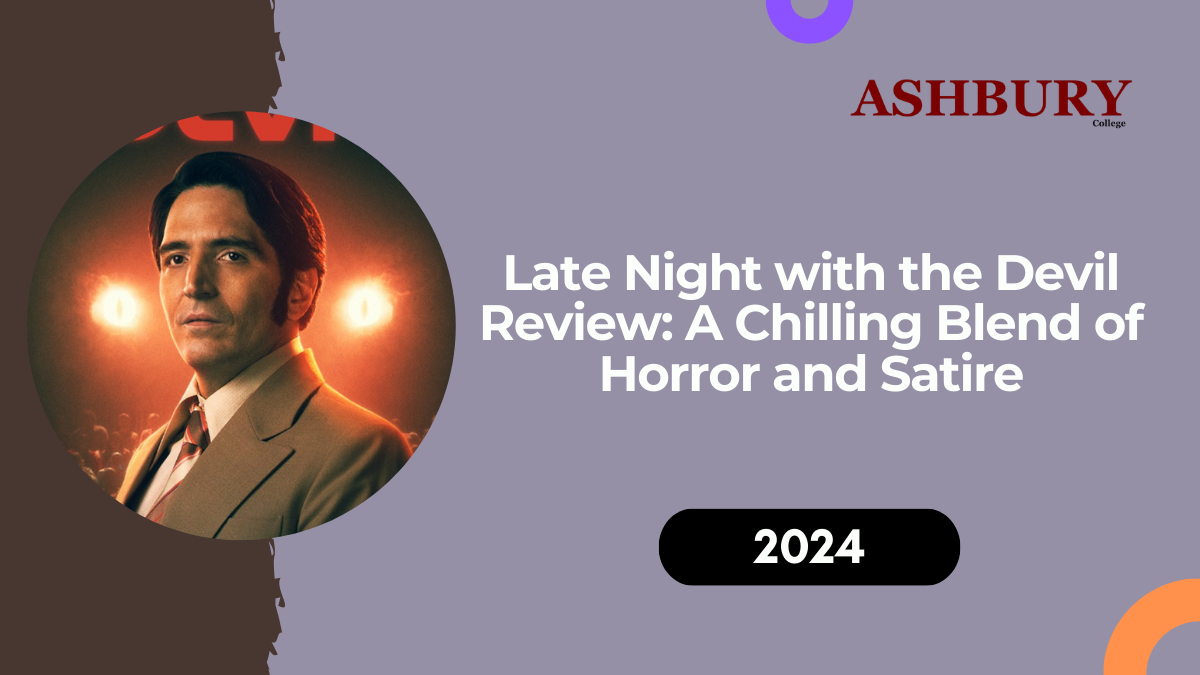Late Night with the Devil brings a fresh twist to horror, cleverly blending supernatural scares with a touch of dark satire. Directed by Australian filmmakers Cameron and Colin Cairnes, this film steps into the 1970s late-night talk show format, offering viewers a haunting yet nostalgic experience. It’s a story that engages both horror fans and fans of retro television, diving deep into the psychological and supernatural horrors that unfold live on air.
Here, we’ll explore what makes Late Night with the Devil a standout in modern horror, analyzing its plot, characters, direction, and unique take on cultural satire.

Overview of Late Night with the Devil
The film is set in 1977 and follows a popular late-night talk show host, Jack Delroy, whose program, Night Owls, draws millions of viewers each night. Desperate for a ratings boost, Jack decides to take a huge risk with a Halloween special, delving into a subject no one would expect to see on a mainstream talk show: the paranormal. What starts as an innocent, if slightly unsettling, segment soon spirals into terror as supernatural forces reveal themselves. The live show unravels before the audience, blending reality and the supernatural in a terrifying and gripping way.
Character Study: Jack Delroy’s Descent
Jack Delroy, played by David Dastmalchian, is one of the most compelling aspects of Late Night with the Devil. Delroy’s character reflects the intense ambition, flaws, and vulnerabilities of a man under pressure. Dastmalchian brings out the layers of Delroy’s desperation—both his fear of fading into obscurity and his willingness to do anything to regain relevance. Throughout the film, Jack’s descent into a state of obsession and fear makes him not just a conduit for horror, but also a tragic figure audiences can empathize with.
The supporting characters add to the suspense and the tension, with each guest on the show bringing their unique personalities, secrets, and supernatural connections. The acting performances of these characters elevate the horror, especially as they react with increasing alarm and disbelief to the escalating chaos. These characters mirror the social obsession with sensationalism and the risks taken in the name of fame and ratings, underscoring the film’s critical message.
The Film’s Blend of Horror and Satire
Late Night with the Devil is far from just a straightforward horror film. The movie employs satire to comment on the nature of media sensationalism and the lengths to which people go for fame. By setting the story in the 1970s—a time when paranormal phenomena and occult practices were deeply embedded in pop culture—the filmmakers tap into a unique cultural atmosphere. The film is replete with references to the era’s fascination with the supernatural and conspiracy theories, giving it a layer of authenticity and a hint of humour.
At the same time, Late Night with the Devil uses horror to expose the fragility of a live television show, where the line between real life and theatrics is perilously thin. The film plays on this tension, building suspense by making audiences question what is real and what is staged. This clever interplay between horror and dark humour makes the film more than just a genre piece; it is a commentary on our society’s insatiable hunger for the sensational and the supernatural.
The Filmmakers’ Retro Style and Direction
Cameron and Colin Cairnes have created a visually authentic 1970s experience, capturing the era’s aesthetic with remarkable detail. The film’s set design, costuming, and cinematography give it a vintage feel that enhances the immersion and helps pull viewers into Jack Delroy’s eerie world. The directors also deserve credit for their innovative storytelling, presenting the film as a live broadcast unravelling in real-time. This choice keeps viewers on edge, mirroring the discomfort of watching something spiral out of control on live TV.
The film’s pacing is carefully managed, balancing slower, tense moments with scenes of intense horror. This allows the suspense to build gradually, culminating in shocking and deeply unsettling scenes. The Cairns brothers succeed in blending elements of psychological horror with supernatural dread, leading to a climax that feels both inevitable and chilling.
Conclusion
Late Night with the Devil is a standout film that succeeds in blending horror, satire, and nostalgia into an unforgettable viewing experience. It’s a fresh entry into the horror genre, skillfully combining psychological scares with dark humour and social commentary. David Dastmalchian’s performance as Jack Delroy is particularly gripping, capturing the essence of a man haunted by his own ambitions and the supernatural forces he has unleashed. For fans of horror and anyone fascinated by the golden age of late-night television, Late Night with the Devil is a must-watch—a clever and chilling film that redefines what horror can be.
This film, with its smart mix of horror and satire, will not only appeal to traditional horror enthusiasts but also to viewers who appreciate social commentary and retro nostalgia. Late Night with the Devil reminds us that sometimes the scariest things are the ones we invite into our own homes, even when they are on our TV screens.
Click here to know more.